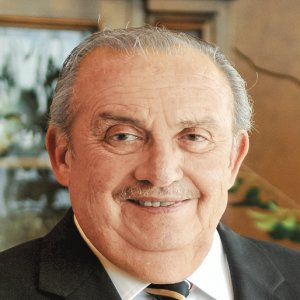Boeing Adapts to Market Trends

STORY INLINE POST
Q: How do trends influencing the Latin American market impact Boeing’s decisions and its attempts to improve passenger experience?
A: We have worked alongside our competition to develop jumbo airplanes, such as the 747, also known as the Queen of the Skies. Over the past 10 years, however, we realized the market was heading in a different direction. Growth was shifting from hub-to-hub destinations toward direct flights to secondary cities. This led us to mirror the trend and invest in the 787 because it is the right size for that market. The 777X, while larger than the 787, can also compete and succeed in this market because it has only two engines.
Having fewer engines represents lower operational costs. Boeing expects to introduce the 777X to the global market in 2020
Latin American airlines are looking for aircraft that can fly longer routes, for which the Boeing 787 is ideal. This aircraft has a range of 13,620km so it can fly as far as China from Mexico. It also is the most comfortable passenger airplane on the market. One of the reasons the aircraft is comfortable is the lower internal pressure as it operates at approximately 6,000ft while others tend to fly at 8,000ft. Operating at this lower altitude generates more humidity. This decreases passenger fatigue and discomfort and allows travelers to arrive at their destination feeling refreshed and less jet lagged.
For medium distances, we are introducing the 737 MAX. This is the new revamped version of the classic 737. This aircraft offers 16 percent reduction in fuel consumption, which leads to significant savings for airlines. It also is a flexible aircraft that can access destinations others cannot, which permits airlines to open new markets to places with less conventional runways.
The Boeing 737 MAX will come to Latin America in 2018 through GOL Airlines in Brazil, Copa in Panama and into Mexico that same year with Aeroméxico.
Q: What is Boeing’s sales strategy for Latin America given the economic fluctuations in the region?
A: Boeing is confident about the performance of the Latin American market. Long-term projections are positive though some short-term challenges certainly exist. We are investing time in fully understanding the region to ensure we are promoting the appropriate products for local operators to maintain a sustainable business model.
Boeing has a large number of operators in Latin America both for narrow and wide body planes, including GOL Airlines, Copa Airlines, LATAM Airlines and Aeroméxico. Our presence in the region is as long as Boeing’s history, which gives us an advantage in terms of industry knowledge and operators. We are interested in allocating our products in all countries in Latin America, from Mexico to Tierra del Fuego.
We have been participants in the Mexican industry for many years, as operators, parts manufacturers and sourcing suppliers based in Mexico. The country has many advantages beyond its ideal location close to the US. Its qualified human capital are key to aerospace developments in the country and the government is dedicated to developing the industry, without which such growth would not have been possible.
The aviation sector is highly competitive. Every airline feels the need to have better aircraft than the competition. Boeing’s aircraft provide lower operational costs and higher performance for Mexico’s airports.
Moreover, to remain competitive, Boeing places a special emphasis on customer support. We have been rewarded for this effort as it has been recognized in recent surveys that our company is the world’s best in customer service.
Q: How important is Aeroméxico for Boeing and what other segments is the company targeting?
A: Aeroméxico is our main partner in Mexico. It operates the 737, a narrow body aircraft that enjoys great market success. Other airlines have preferred to match different aircraft to their business models and once an airline chooses a specific type, it is difficult for it to deviate because that would result in significant costs. Aeroméxico made an order for 100 units in July 2012 of varying types of aircraft, including the 737 MAX, which increases fuel efficiency by 1.8 percent due to its new winglet, and the 787-8, which generates 20 percent less CO2 emissions and keeps noise levels to 85 decibels, a benchmark that is 60 percent less than Boeing’s 767 and below ICAO’s regulations.
Major low-cost airlines including Ryanair, Southwest Airlines and WestJet, are using our aircraft. These airlines represent a great business opportunity for us because we have a product designed for them. We recently launched the 737 MAX 200, which reduces the fuel-cost per seat by 20 percent and is ideal for low-cost airlines due to its size and specifications.
Q: What are the main advantages granted by new aviation technology and how are your operations changing to accommodate them?
A: Technology has brought about benefits such as improved reliability. Composite materials are reducing airplane weight while maintaining its strength and durability. Until recently, all aircraft required four engines for safety reasons. Modern aircraft only incorporate two, as new engines are more reliable than their predecessors.
Maintenance times also have been reduced, greatly improving operational costs and reducing ticket prices enough to make overseas flights accessible to a larger segment of the population. Boeing focuses heavily on reliability because that is what helps our customers successfully and safely operate and grow their businesses.
Airplanes and air travel still have limitations. The duration of a flight can be longer than desired due to air traffic control, the type of aircraft and the available time slots at the airport. In the case of aircraft, while there is sufficient technology for airplanes to fly faster, as evidenced by the Concorde, these technologies are too expensive, in spite of the fact that the ticket prices keep dropping.
The cost of fuel consumption and engine maintenance counteracts the cost saved by flying faster. The Concorde itself did not have the expected popularity, as it cost up to five times more than regular business class and the aviation industry is keen to increase access to all economic levels of the population.
Q: What must be done to expand the use of biofuel in aircraft?
A: One of the advantages of modern aircraft is they can use biofuel. Aeroméxico recently used it for a flight to Costa Rica from Mexico but its use remains unpopular or less common because its production is expensive. We are investing in developing better ways to manufacture biofuels, which will reduce the environmental impact of our aircraft. Boeing constantly develops new technologies in many areas, from propulsion systems to aircraft designs aimed at offering more competitive, efficient products with smaller environmental impacts.
Q: How many Boeing airplanes do you expect Mexican airlines to acquire in the short term considering existing market needs?
A: Over the next 20 years, Mexico will need to replace 60 percent of its existing aircraft. Ideally, Boeing would replace 100 percent of that number projected to be renewed.
We dominate the wide body market in Mexico and hold an approximate 70 percent share in the global market. Mexican airlines interested in operating international flights will turn toward Boeing. We expect to retain 50 percent of the Mexican narrow body market and are introducing new products and excellent services to ensure this. Boeing is the leader in aviation.
Although our competition may have more aircraft orders, we have a higher delivery rate than anyone in the market, which is what really matters.






















